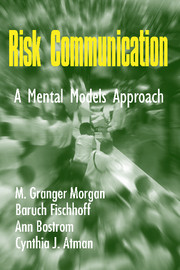Book contents
- Frontmatter
- Contents
- Preface
- Risk Communication
- 1 INTRODUCTION
- 2 OUR MENTAL MODELS APPROACH
- 3 CREATING AN EXPERT MODEL OF THE RISK
- 4 MENTAL MODELS INTERVIEWS
- 5 CONFIRMATORY QUESTIONNAIRES
- 6 DEVELOPMENT AND EVALUATION OF COMMUNICATIONS
- 7 CASE STUDIES: APPLICATIONS TO ENVIRONMENTAL RISKS
- 8 A MENTAL MODELS APPROACH TO HIV/AIDS
- 9 SOME CONCLUDING THOUGHTS
- Appendix A Brochure on global warming and climate change
- Appendix B Brochure on fields from electric power
- Appendix C Risk communication materials on HIV/AIDS
- Appendix D Sample transcripts of mental model interviews
- Index
2 - OUR MENTAL MODELS APPROACH
Published online by Cambridge University Press: 05 June 2012
- Frontmatter
- Contents
- Preface
- Risk Communication
- 1 INTRODUCTION
- 2 OUR MENTAL MODELS APPROACH
- 3 CREATING AN EXPERT MODEL OF THE RISK
- 4 MENTAL MODELS INTERVIEWS
- 5 CONFIRMATORY QUESTIONNAIRES
- 6 DEVELOPMENT AND EVALUATION OF COMMUNICATIONS
- 7 CASE STUDIES: APPLICATIONS TO ENVIRONMENTAL RISKS
- 8 A MENTAL MODELS APPROACH TO HIV/AIDS
- 9 SOME CONCLUDING THOUGHTS
- Appendix A Brochure on global warming and climate change
- Appendix B Brochure on fields from electric power
- Appendix C Risk communication materials on HIV/AIDS
- Appendix D Sample transcripts of mental model interviews
- Index
Summary
The Need for a Systematic Approach
An effective communication must focus on the things that people need to know but do not already. This seemingly simple norm is violated remarkably often in risk communications. Rather than conduct a systematic analysis of what the public believes and what information they need to make the decisions they face, communicators typically ask technical experts what they think people should be told. Rather than subject draft communications to rigorous empirical evaluation by individuals like those who will use them, communicators pass them around to staff or expert committees for approval. Those passing judgment may know very little about either the knowledge or the needs of the intended audience.
Under such conditions, it is not surprising that audiences often miss the point and become confused, annoyed, or disinterested. If the communicators feel that they have done everything that is expected of them, they may conclude that their audience was responsible for the communications failure. If the public is blamed for being stupid, irrational, or hysterical, it is deprived of both information and respect in the future.
In some cases, the failure to inform reflects willful neglect or disinterest. Communicators would just as soon not have the public know the facts, or they may lack the resources needed to take this part of their job seriously. More often, though, we suspect that the failure reflects the lack of systematic procedures for finding out what people know and need to know, and for confirming empirically that a communication has been effective.
Information
- Type
- Chapter
- Information
- Risk CommunicationA Mental Models Approach, pp. 19 - 33Publisher: Cambridge University PressPrint publication year: 2001
